PinotFile: 8.15 May 24, 2010
|
Hanzell Vineyards: Revered After More Than 50 Vintages
........ Winemaker Brian Croser, The World of Fine Wine, Issue 26, 2009
In the rush to find the latest cult Pinot Noir, we often neglect the heritage wineries of California that are cherished for their long tradition of excellence. Hanzell Vineyards was one of California’s first boutique wine estates, and among producers of both estate grown, produced and bottled Pinot Noir and Chardonnay, is exceeded in longevity by only Mount Eden Vineyards. Martin Ray started his eponymous and innovative winery in the early 1950s (it became known as Mount Eden Vineyards in 1972) at a time that diplomat James D. Zellerbach and his wife, Hana, acquired land in the Mayacamas Mountains one mile north of the Sonoma Plaza. The Zellerbachs planted their first Pinot Noir in 1953 using cuttings from the Martin Ray estate (now commonly referred to as the Mount Eden clone). The legend holds that the Martin Ray Pinot Noir cuttings were acquired in a clandestine late night raid on a Napa Valley vineyard by Hanzell’s first winemaker, Brad Webb. At Hanzell, small amounts of wine were sold starting in 1957, but 1965 was the first full-scale commercial vintage. The original Pinot Noir vines at Mount Eden Vineyards were pulled out in 1997 and the original 2.2-acre block of Pinot Noir at Chalone planted in 1946 was replaced in 2003, making the original plantings at Hanzell the oldest continually producing vineyard of Pinot Noir and Chardonnay in the New World. Selections from the original plantings at Hanzell have become known as the “Hanzell clone,” and have been planted throughout California.
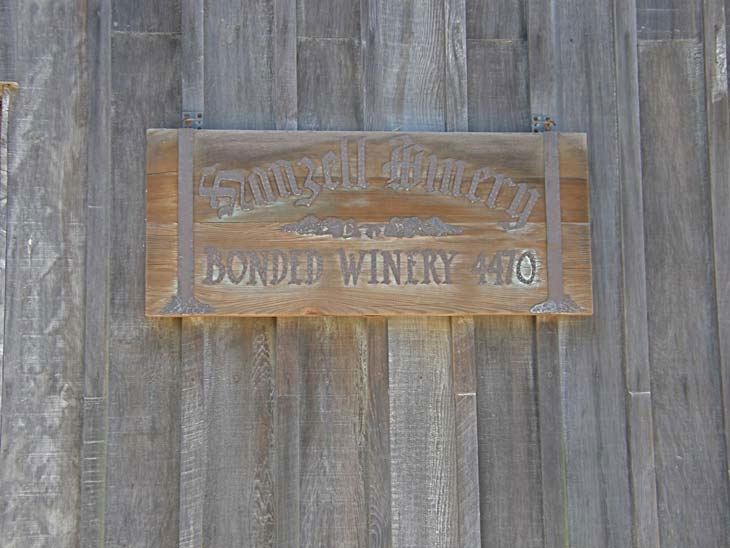 James D. Zellerbach became fond of Burgundy and its wines while serving in Europe as the American Ambassador to Italy. He was sent by President Truman to head the implementation of the Marshall Plan in Italy after World War II. Zellerbach was also the President of Crown Zellerbach, a large forest products company of the time. A 200-acre property overlooking the town of Sonoma was acquired in 1948, and in 1956 after returning from Italy, the Zellerbachs constructed a small gravity-flow winery of redwood and indigenous stone fashioned after the press building at Burgundy’s famed Clos de Vougeot. Zellerbach hired Ralph Bradford (Brad) Webb (1922-1999) in 1956 as winemaker and together they set out to combine Burgundian winemaking traditions with New World innovations. Reportedly, after hiring Webb as winemaker, Zellerbach gave him a bottle of DRC Romanee-Conti and told him he wanted to produce wine like that. Many winemaking “firsts” were developed by the pair at Hanzell, but Webb in particular has failed to receive the recognition for his winemaking innovations. In a recently published article in Wines & Vines (“Hanzell and ML 34,” January 2010), author John L. Ingraham, a microbiologist and assistant professor of enology at University of California at Davis in the 1950s and a collaborator with Webb, described how the pair isolated the ML 34 strain, now designated as the genus and species Oenococcus oeni, sourced from the Louis M. Martini Winery. Webb had been perplexed by the failure of malolactic fermentations to start in the new winery at Hanzell Vineyards. In the 1950s, malolactic fermentation was incompletely understood. Ingraham notes, “In 1959, Webb and I took ML 34 to Hanzell to study it under winery conditions. There, we added 100ml of a culture grown in a medium nutritionally enriched with tomato juice to 4 gallons of must that had been fermented to 1° Brix. Two days later, all its malic acid was gone. Then we added 200ml of the lees of this starter culture to a 100-gallon lot of Pinot Noir must that had been fermented to 3° Brix, again initiating a malolactic fermentation that completed 21 days later.” Webb exclaimed later in an interview, “That was the most exciting moment of my life, really.” The pair were not the first to induce malolactic fermentation from a pure culture of a known strain of bacterium, but Hanzell was the first winery in North America to complete induced malolactic fermentations. If you visit Hanzell today, you can still see Tank 21 (pictured below), one of the original glass-lined stainless steel tanks at the winery and the one in which the first malolactic fermentation occurred.
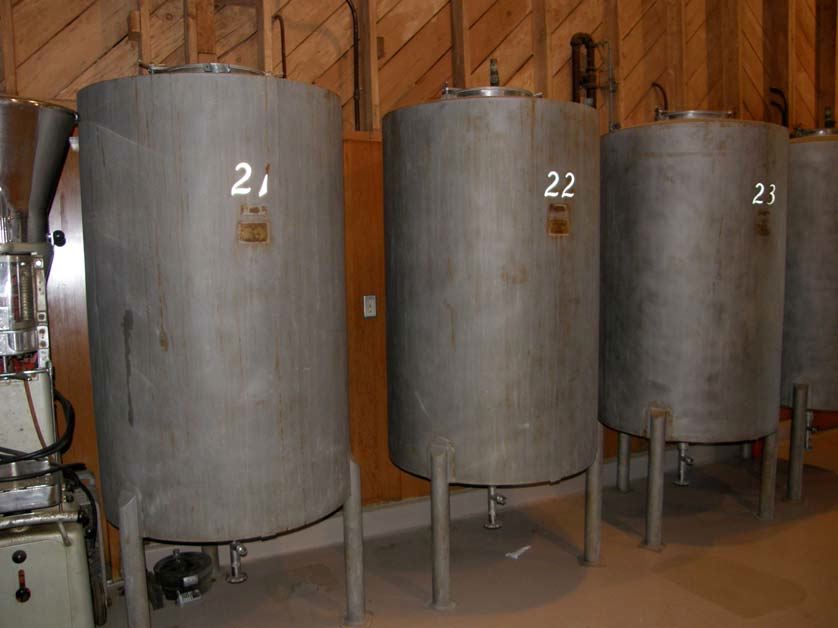 There were many other firsts at Hanzell. Custom designed one ton stainless steel fermenters were the first of their kind to allow complete control of fermentation temperature. Within the double walls, coolant circulated, dissipating the heat of fermentation to maintain a desired temperature. Today, there are jacketed stainless steel tanks in practically every winery in the world. The use of inert gas to blanket young wine in tank was relatively unknown in the 1950s. Webb outfitted the tanks at Hanzell with fittings that allowed nitrogen to cover the wine during aging, and at bottling, every bottle was treated with nitrogen just before it was filled with wine. The practice of using inert gas is commonplace in winemaking today. Hanzell was the first California winery to exclusively use French oak barrels for aging wine. In the late 1950s and early 1960s, California wineries aged wines in large vessels, often made of redwood, or in small barrels composed from American oak. Zellerbach and Webb realized that small French oak barrels had to be used to replicate the wines of Burgundy. The winery’s use of imported Sirugue French oak barrels had a major affect on the quality of the wines produced and the wine industry quickly recognized the merits of French oak aging. The 2007 vintage marks the 50th year that Hanzell has used Tonnellerie Sirugue. The “Hanzell house style” was developed by Brad Webb and has been maintained through over 50 vintages by winemakers Kim Giles, Bob Sessions (28 vintages beginning in 1973), Michael Terrien, and today, Michael McNeill. Hanzell has never succumbed to the oaky, buttery style of California Chardonnay or the highly extracted, ripe and fruit-driven style of California Pinot Noir that have become so popular over the last twenty years. Rather, the style emphasizes restraint, nuance, subtlety, food compatibility and above all, age ability. The wines speak of the unique terroir of this hillside estate, blessed with a concentration of Red Hill volcanic soil rarely found in Sonoma County (see photo below) and cooled by the winds from the Petaluma Gap. At Hanzell, the emphasis is on the vineyard and not the winemaker who is but a shepherd of the Hanzell tradition. Michael McNeill, who blended and bottled the 2007 vintage and crafted the 2008 vintage in its entirety, told me, “I don’t want my fingerprints on the wine.”
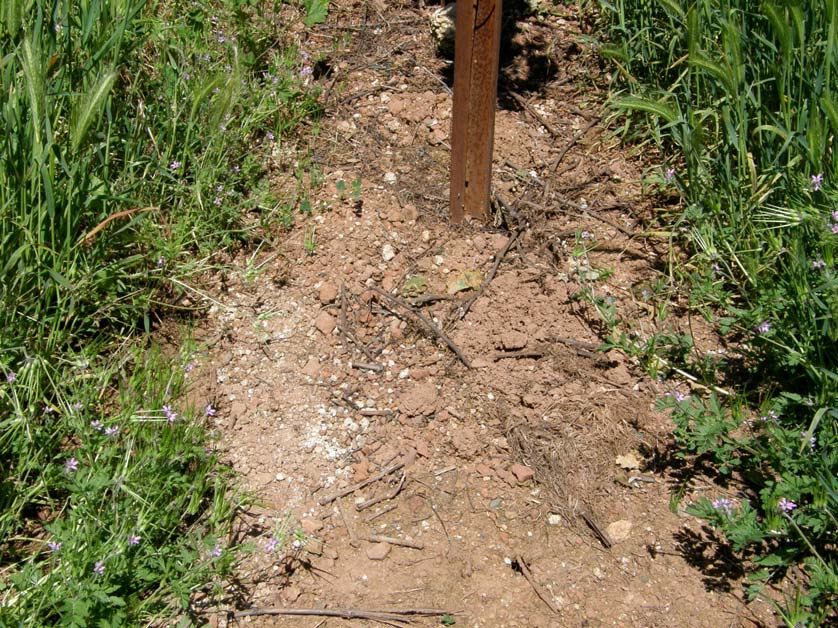 Michael McNeill (pictured below in the Hanzell wine library) has crafted wine for the past two decades in California, Oregon and Burgundy. His experience at Chalone Vineyard with Michael Michaud left him with a reverence for the time-honored traditions of winemaking. He works closely with Winemaker Emeritus Bob Sessions and Jose Ramos, Director of Vineyard Operations. Bob Sessions was the winemaker and general manager of Hanzell Vineyards from 1973 to 2001. He began his winemaking career at Mayacamas Vineyards in 1964 under the guidance of Brad Webb, Hanzell‘s winemaker at the time. He left Mayacamas to become production manager for Souverain Cellars (now Rutherford Hill) and then joined his friend Warren Winiarski to start Stag’s Leap Wine Cellars. While that project was in its early stages, he was lured to Hanzell Vineyards by Brad Webb in 1973. Sessions was able to recognize Ambassador Zellerbach’s vision for the property and maintain the goal of age-worthy terroir-driven wines for nearly three decades.
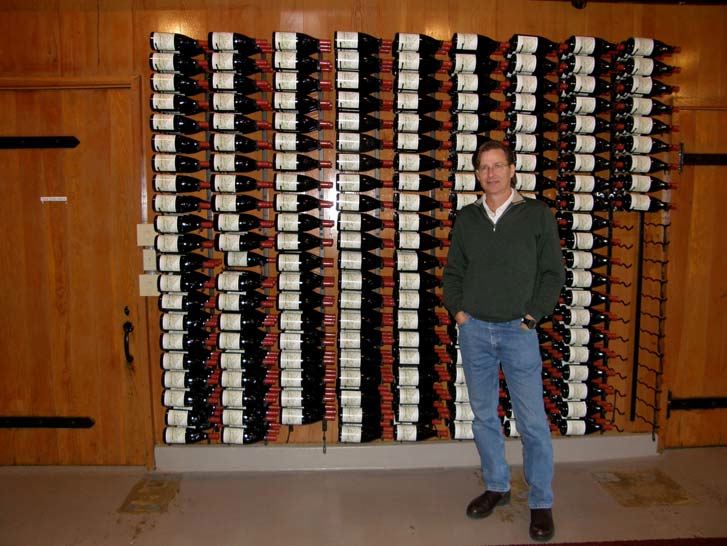 A new winemaking facility and cave were completed in July 2004 to accommodate the increased wine production which has now grown to 6,000 cases of estate grown, estate produced and estate bottled Pinot Noir and Chardonnay annually. In 2002, Wine Spectator writer and critic James Laube contacted Hanzell about TCA taint in blind tastings of the winery’s 2000 Chardonnay. Testing at ETS Laboratories in Napa Valley showed elevated TCA levels in both Hanzell Chardonnay and Pinot Noir of 2.6 and 3.2 parts per trillion. Initially, Hanzell, led by then President Arnold’s conviction that the TCA contamination should be made public, was quick to acknowledge the problem and stopped sales of the current release wines. Sommeliers and distributors continued to support the quality and desirability of the wines. Extensive testing at the winery revealed TCA contamination on barrels, hoses, equipment and in the air. It was decided that years of chlorine use as a disinfectant was the culprit. Consumer testing revealed that most were not cognizant of the TCA levels in the Hanzell wines and the 2000 Chardonnay and 1999 Pinot Noir were re-released. At the time, Hanzell was building its new winery and the TCA contamination problem was eradicated with the transfer of production to the new facility. Arnold’s actions alerted many producers about the dangers of using chlorine in their own wineries and she received much-deserved widespread praise from the wine industry. The Hanzell estate consists of the following vineyards (refer to vineyard map below). 14 acres are planted to Pinot Noir and 28 acres to Chardonnay. The 12-acre Zellerbach Vineyard, planted in 1953, also referred to as the “Ambassador’s 1953 Vineyard,” consists of St. George rootstock grafted to Mount Eden Pinot Noir and Wente Chardonnay. The terraced and contoured vine rows have a western exposure with slopes up to 15%. Soils are Raynor-Montara Complex type. The 5-acre Day Vineyard was first planted by Douglas and Mary Day, proprietors from 1965 to 1975, and consists of St. George rootstock grafted to Hanzell Chardonnay sélection massale from the Zellerbach Vineyard. Half of the original planting remains and half was replanted in 1998 to Chardonnay. The vineyard is terraced and contoured with southwestern exposure and slopes up to 20%. Soils are Raynor-Montara Complex type. The 16-acre de Brye Vineyard was first planted by the de Brye family in 1976 and is composed of St. George rootstock grafted to Hanzell Chardonnay and Pinot Noir sélection massale from the Zellerbach Vineyard. Terraced and contoured vine rows have southern exposure with slopes of 10%. Soils are Red Hill Clay Loam. The 4-acre Sessions Vineyard, planted in 1999, honors Hanzell’s winemaker, Bob Sessions. There are 11 sub-blocks, each planted with a unique rootstock and scion combination. The southeastern exposures catches the morning sun and enjoys minimal direct light during the peak of the day. Rows are planted against the contours with a 38% slope. Soils are Red Hill Clay Loam type. The 5-acre Ramos Vineyard, named in honor of Hanzell’s vineyard manager of 30 years, José Ramos, was planted in 2001. The vines are St. George rootstock grafted to Hanzell Chardonnay sélection massale from the de Brye and Zellerbach vineyards. Exposure is northwestern with rows planted against the contours. Soils are Red Hill Clay Loam type.
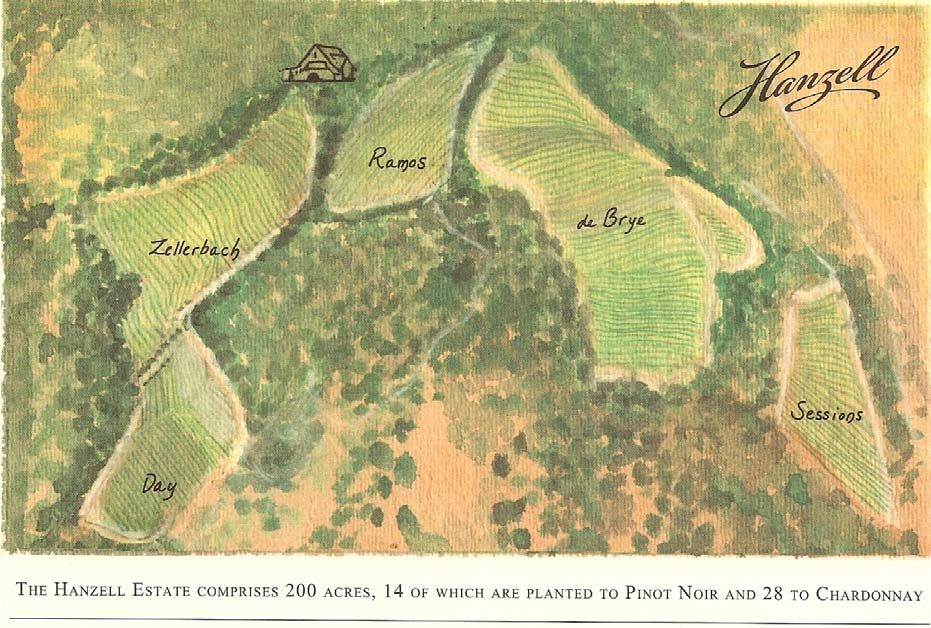
I visited Hanzell Vineyards recently, toured the vineyards and tasted with Michael McNeill. As we stood
overlooking Zellerbach Vineyard, he spoke to me about the history of Hanzell Vineyards and his “dream job.”
Listen to our conversation: “Conversation with Michael McNeill of Hanzell Vineyards"
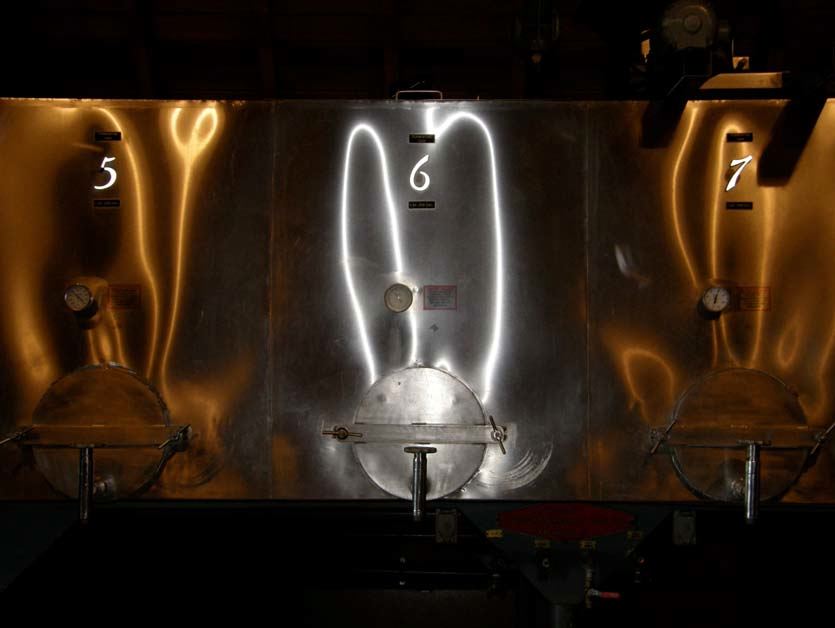
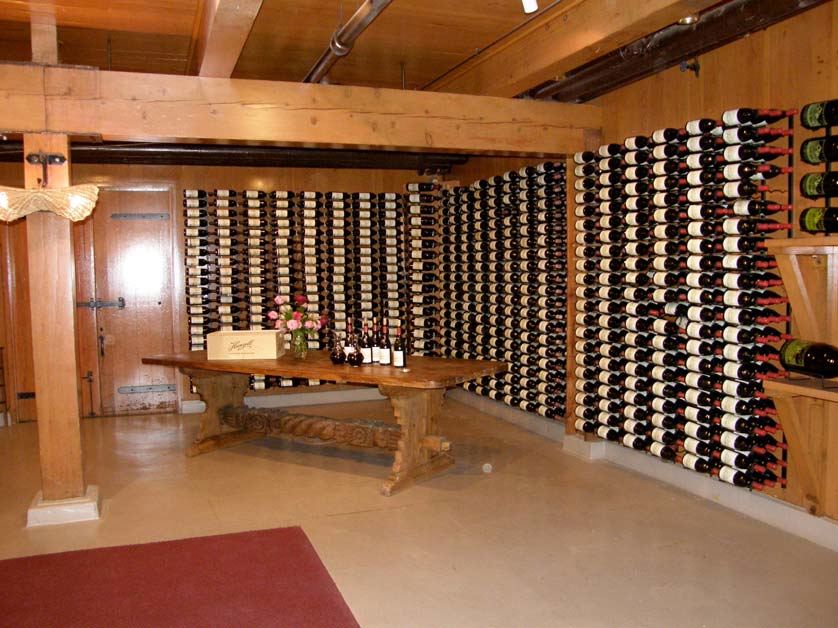 The photos that follow show the Zellerbach Vineyard and the town of Sonoma beyond, an original vine in the Zellerbach Vineyard, and the Sessions Vineyard.
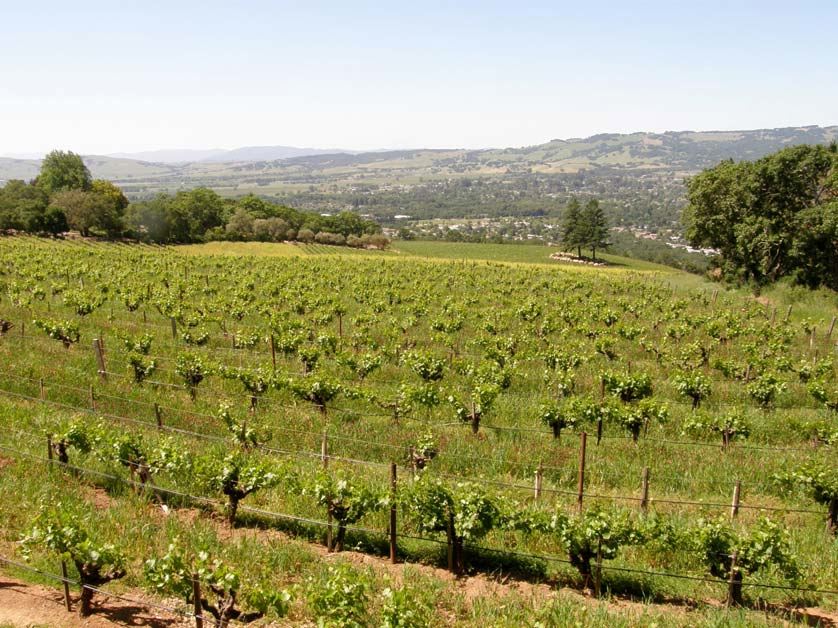
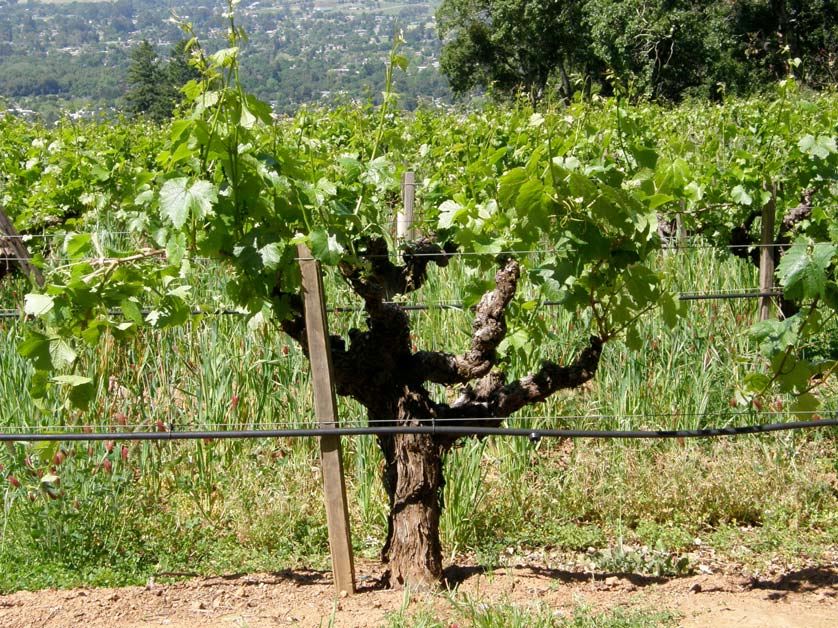
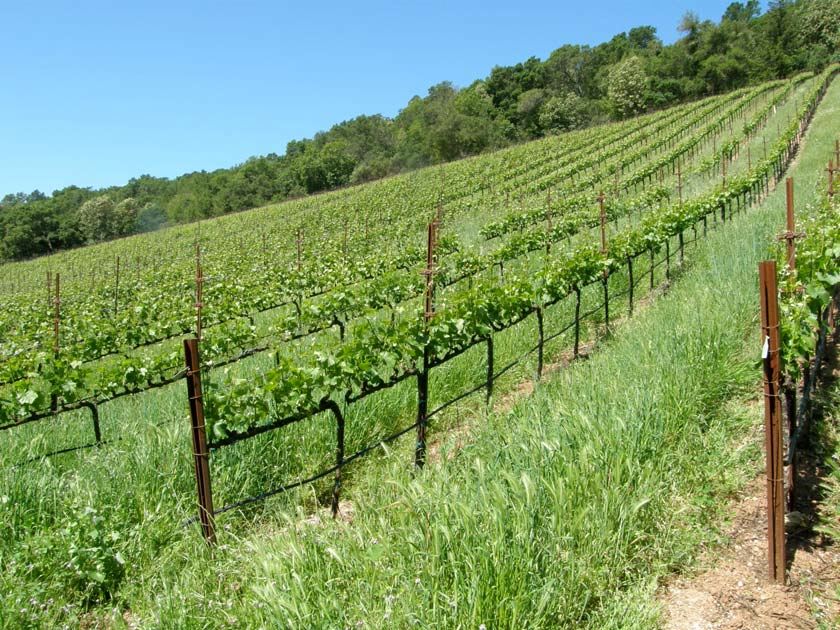 I tasted four vintages of Hanzell Pinot Noir from 1995, 2001, 2003 and 2007, all of which had been decanted over fours hours in advance. As dictated by tradition and the house style, the Hanzell wines are aged in Sirugue barrels, 50% new in the case of Pinot Noir and about 33% new for the Chardonnay. The Sirugue barrels are said to produce pure fruit expressions in Chardonnay with smoky vanillin and fresh-baked bread aromas and highlight tropical and lemon components. For Pinot Noir, the Sirugue barrels add finesse and subtle aromatics of exotic spices and roasted herbs. The Pinot Noir grapes are 100% de-stemmed, cold soaked for 5 to 7 days in one-ton fermenters, and kept in contact with the skins for two weeks following fermentation. Clone and rootstock combinations as well as vineyard blocks are vinified separately until blending decisions are made shortly before bottling. Surprising as it may seem, given the distinct differences between each of the individual vineyard blocks as to elevation, aspect, slope, vine age, trellising, and clones and rootstocks, the different lots share many characteristics while retaining subtle differences. The recent vintages of Pinot Noir are sourced from Sessions, de Brye and Zellerbach vineyards. All the wines displayed a moderate garnet robe with the older vintages displaying impressive retention of fresh color. The wines were intriguingly complex, offering nuances that played hide and seek with my senses and I would have happily spent the day revisiting each glass if time had permitted. If you are a connoisseur of fine Pinot Noir and Chardonnay, you owe it to yourself to visit Hanzell at least once. The historical property, the unique wines, and the warm reception will ingratiate you to Hanzell for the rest of your life. There just isn’t anything quite like this cherished winery.
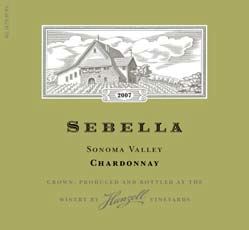 2007 Sebella Sonoma Valley Chardonnay 14.2% alc., 762 cases, $36. Named after the owner’s children, Sebastian and Isabella. Selected from barrels, many from newer Chardonnay vines, and crafted for current drinking. 30% barrel fermented, 18 months total elevage, 12 months in 30% new Sirugue French oak barrels. · Pale straw color in the glass. Delicately perfumed and highly nuanced revealing aromas of poached apple, freshly toasted brioche and brown butter. Clean and bright on the palate with flavors of red apple, baking spices and citrus. A lovely drink whose bright acidity refreshes every sip. Good.
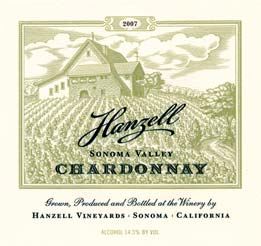 2007 Hanzell Sonoma Valley Chardonnay 14.3% alc., 2,777 cases, $70. Several clones including Robert Young, Dijon 76 and Wente. One-third of the wine fermented and aged in new Sirugue French oak barrels where MLF was encouraged and the balance fermented cool, in stainless steel tanks where MLF was discouraged. The new barrel component was aged 18 months and the tank-fermented portion was put into two and three-year old barrels after 6 months and kept an additional 11 months before blending and bottling. 69% of the vintage was selected for the estate bottling. · Pale straw color in the glass. Delicate, yet complex aromatic profile that picks up intensity with time in the glass to reveal scents of white peaches, crushed stones, toasted brioche and lemon tart. This high-collared wine strikes a perfect balance between welcoming finesse and impressive finishing strength and persistence. Smoothly textured with a well proportioned grip of acidity and a very appealing underlying minerality. Flavors of golden apple, white stone fruits and subtle toast develop strength and brilliance with air time. If you must open a bottle now, decant. A very classy wine that will hold its own against many Grand Crus white Burgundies. Older vintages of Hanzell Chardonnay are available on the secondary market through the internet and these will make for remarkable drinking experiences as well.
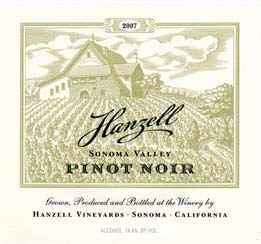 2007 Hanzell Sonoma Valley Pinot Noir 14.4% alc., pH 3.7, 1,361 cases, $95. Aged 18 months in 50% new Sirigue barrels. · Still tight but this will be a 20 to 30 year wine. Well-scented black cherry fruit lurks behind scents of oak and underbrush. Rich and satisfying sweet berry and cherry fruit with healthy tannins and a huge, dry and fruity finish. Plenty of power but the tannins and acidity bring everything into focus. Down the road this wine has limitless potential. Lay it down for several years and then party like it was 2007.
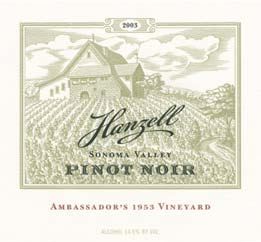 2003 Hanzell Ambassador’s 1953 Vineyard Sonoma Valley Pinot Noir 14.6% alc.. · Aromas of fresh black cherries amped to a high level. Bright and opulent on the nose with an interesting mineral edge. My notes say, “Remarkable!” Intensely flavored but light on its feet, with a discreetly concentrated core of cherry and berry fruit set off by notes of bark, peat and spice. Well-structured with the ripe, soft tannins seemingly caressing the fruit in velvet. A remarkable wine that I felt honored to drink and one of the greatest California Pinot Noirs I have ever tasted.
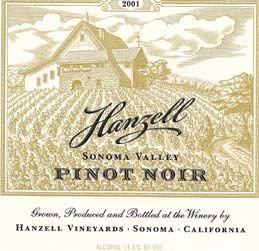 2001 Hanzell Sonoma Valley Pinot Noir 14.6% alc.. · A complex perfume of fresh black cherries, red anise, rock, berries and rose petals. Medium weighted with more structure and fruit than the 1995 version offering flavors of slightly tart dried cherries, cherry skins, and berry jam. Delicious with noticeable persistence on the bright finish. An impressive wine with a lovely sensual modesty. Very good.
 1995 Hanzell Sonoma Valley Pinot Noir 13.8% alc.. · The nose struck me as very “Burgundian,” sporting fresh aromas of black cherries, black raspberries, underbrush and exotic woods. A chameleon in the glass offering many layered flavors of dried cherries, macerated berries, loamy earth, and savory herbs. The tannins have melted and the well-proportioned acidity brings everything into balance. A treat. Very good.
Hanzell Vineyards wines are available for purchase on the website at www.hanzell.com. The Ambassador’s Circle Wine Club guarantees access to the Hanzell Vineyards Pinot Noir and Chardonnay as well as the 1953 Ambassador Vineyard releases, magnums, and library vintages. Guests are received by appointment only (707-996-3860).
DuMOL: Scottish Thread Runs ThroughThere are some wineries in California that don’t attract the media frenzy but have become our most treasured producers of Pinot Noir and Chardonnay. DuMOL, which was named after the first winemaker’s children, Duncan and Molly, has that tradition. Since its inauspicious beginning in 1996, DuMOL has developed a devoted cadre of followers. Today, DuMOL has an established list of vineyard sources, now numbering twenty- three, a talented winemaker in Andy Smith, who has been at the helm since 2000, and a modern, well-outfitted winery in Windsor, California that opened in time for the 2008 harvest.
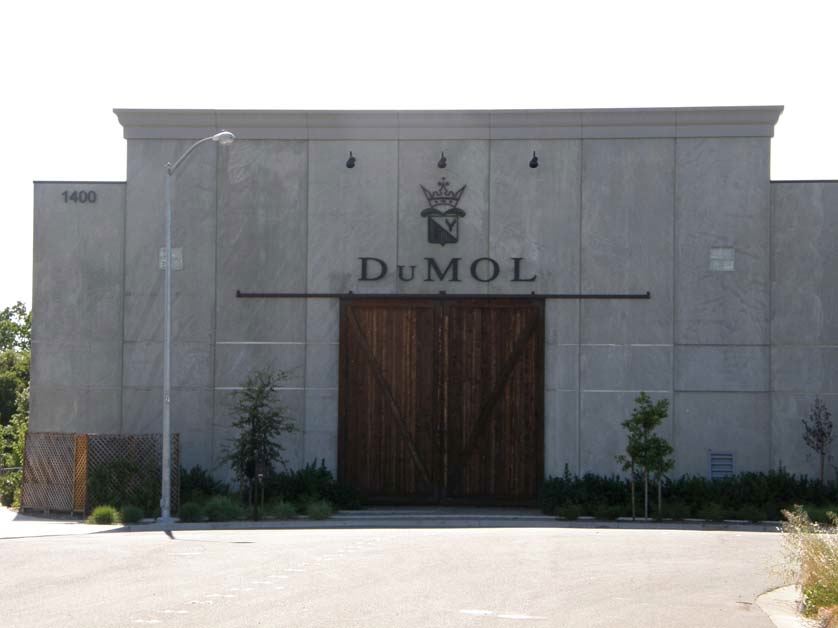 Partners Michael Verlander, Kerry Murphy and Andy Smith prefer to lead a low profile with discrete participation in public tastings and minimal emphasis on wine critics’ scores which they do not heavily tout in their marketing materials. This attitude does not reflect any smugness by the proprietors, but rather an emphasis on investment in the quality of the wines and a preference for letting the wines speak for themselves. The priority at DuMOL is on blending grapes from various compatible vineyard sources, producing single vineyard wines only when the vineyard warrants. The wines are not named for the principal or only vineyard used in crafting a particular wine, but instead the names of family members of the winery principals. Most of the grapes are sourced from the Green Valley appellation where DuMOL has a 25-acre Estate Vineyard, with other grape sources originating in the Russian River Valley, Sonoma Coast and Carneros. The DuMOL Estate Vineyard was featured in a recent article on Small Vines Viticulture (see PinotFile, Volume 8, Issue 13). Contracts have been in place for some time and are long term. Grapes are paid for by the acre, insuring that farming can be directed and yields can be restricted. Upon first meeting with Andy Smith, many people think the winemaker’s accent is Australian, as there are a number of Aussie winemakers in California, but he is Scottish. Before his tenure at DuMOL, Smith studied under Neil McCallum (Dry River in Martinborough), Ted Lemon (Littorai) and Paul Hobbs, all distinguished winemakers of great repute. Smith also serves as the winery’s viticulturist. Since arriving at DuMOL in 2000, he has slowly tweaked the DuMOL style from a ripe, big and fruity style, to wines with more restraint and charm, often picked at more modest but physiologically ripe sugar levels of 23.5° to 24.5° Brix ( a goal many wineries are now striving for), with brighter acidity, fresher and less extracted fruit and more moderate alcohols. Smith told me, “I like to get the fruit off before it gets too ripe.”
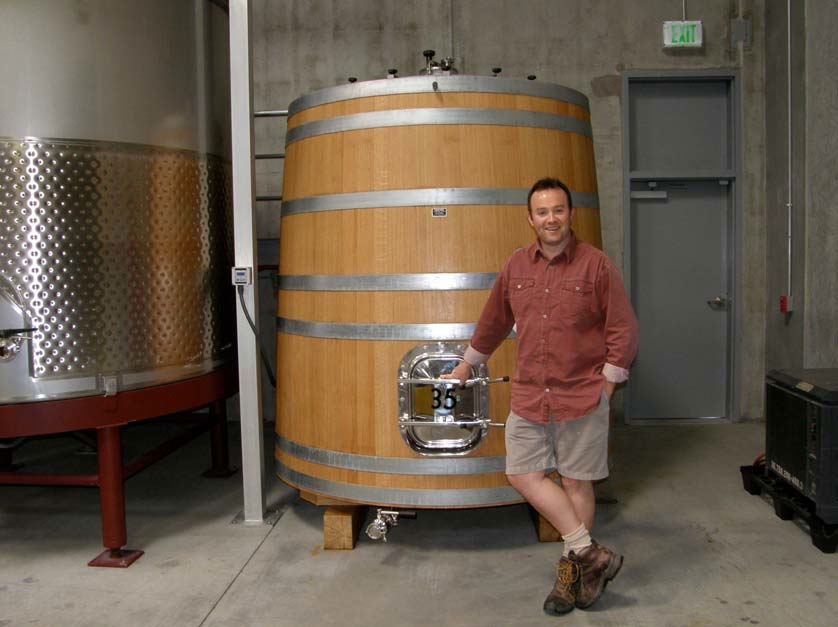 Robert Parker hailed Andy Smith as one of the “World’s Most Influential Wine Consultants,” listing him among other internationally acclaimed winemakers such as Helen Turley, Mark Aubert, Michel Rolland and Paul Hobbs. Another of the trio of proprietors, Kerry Murphy, is first generation Scottish-Irish and was born and raised in San Francisco. He worked in his family’s tire business, Murphy’s Inc., which became the third oldest Michelin distributor in the United States. Murphy’s association with Michelin primed his interest in fine wines and after the sale of the tire business to Goodyear, he pursued a career in the wine industry. Michael Verlander had a successful career in the hospitality industry beginning in 1977, and until 2004 owned a very popular Italian restaurant in Walnut Creek, California named PRIMA Restaurant and Wine Shop. You can follow him on Twitter (www.twitter.com/dumol). The percentage of whole cluster in the DuMOL Pinot Noirs is different each year and for each vineyard based on an intuitive feeling as harvest approaches in each vineyard. There is no recipe. Smith likes to use 10%-15% whole cluster where possible, but finds himself using more whole cluster with each vintage. In 2008, for example, he used the most whole cluster ever to build in some extra freshness and aromatic complexity in the face of the early September heat. Smith said, “This worked and the wines have a lovely crunchy red fruit quality that I love and a bright freshness that belies the vintage conditions.” The cooperage regimen for Pinot Noir is as follows. Each bottling is raised in 50% Remond and 50% Ermitage barrels that are tight grain. The percentage varies between 40% and 50% with the “bigger” cuvées receiving a maximum of 50%. Stave wood is air-dried 3 years minimum and toasting is light or medium only. No heavy medium or heavy toast is used as Smith finds the results clumsy and overbearing. The Russian River Valley bottling is aged 11 months in oak and 3 months in tank and the designates are aged 15 months in barrel. The Russian River Valley lots are only racked one time to tank and the designates are racked when selections are made in the spring and again at bottling. Although the wine press has claimed Smith’s stock-in-trade is Burgundian-styled wines, I find the wines respectfully Californian in pedigree. He has demonstrated a gift for blending multiple sites, clones and maturity levels to achieve his goals and the results have captured wine lovers’ attention. All the DuMOL Pinot Noirs are crafted with native fermentations and are bottled unfined and unfiltered. DuMOL wines are highly flavorful and seductive when young, but benefit from at least a few years of aging and have the potential for successful midterm aging of 7 to 15 years.
I recently spent an afternoon with Andy Smith at the DuMOL winery and recorded his comments about the
winery and his winemaking goals: “Conversation with Andy Smith of DuMOL"
14.5% alc., 185 cases, $65, released December 2009. The first Estate Pinot Noir bottling. Calera and Swan selections with yields of 2 tons per acre average. Native yeast primary and ML fermentations, aged 14 months in 50% new French oak barrels, bottled unfined and unfiltered. · Appealing aromas of cherries, cola and savory herbs. Well-structured and pleasing with flavors of red cherries and berries accented with notes of cola and baking spices. Crisp and smoothly textured with an extended aromatic finish. Very good.
2007 DuMOL eoin Sonoma Coast Pinot Noir 14.1% alc., 375 cases, $74, released December 2009. The first bottling from Richard Hyde’s Sonoma Stage Vineyard. 50% each Calera and Swan selections cropped at 2.8 tons per acre. 25% whole cluster, native yeast primary and ML fermentations, aged 14 months in 45% new French oak barrels. Unfined and unfiltered. · Moderately deep reddish-purple color in the glass. Complex and nuanced with aromas of purple stone fruits, savory herbs and crushed berries, with flavors replicating the aromas offset by notes of plum and truffle. Still showing youthful tannins and immaturity, and will reward the patient. Very good.
2007 DuMOL finn Russian River Valley Pinot Noir 14.5% alc., 363 cases, $80, released December 2009. The eighth finn bottling and according to winemaker Andy Smith, “The finest wine we have ever grown and produced.” Named after Andy’s son. Sourced from Occidental Vineyard (50%), Widdoes Upper Vineyard (35%), and Sonoma Stage Vineyard (15%). 2.25 tons per acre average. Calera, Swan, and Martini selections with Pommard clone. Aged 14 months in 62% new French oak barrels. Unfined and unfiltered. · A stunning wine with complex aromas and flavors of dark fruits, cut flowers, underbrush, earth and spice. Still has tannins to shed but offers a big mouthful of hedonistic flavor that coats every nook and cranny in the mouth. The tremendous fruit concentration is well buffered by the tannins and acidity. A superb wine that will thoroughly please any Pinot Noir lover.
 2006 DuMOL Russian River Valley Pinot Noir 14.1% alc., 2,700 cases, $60, released June 2008. This appellation wine is released earlier than the namedesignated wines offering earlier accessibility. That said, the appellation wine can often age quite well and Smith finds that over time the appellation wine can turn out to be one of the best wines in the lineup. A 6-vineyard blend from Dutton-Gregori, Dutton-Widdoes, Hanna, Hansel, Sonoma Stage and Sundawg Ridge. Clones are Old Beringer, Pommard, Dijon 114, 115, 777 and Calera and Swan selections. Yields average 3 tons per acre. Aged 11 months in 45% new French oak barrels. · Very drinkable now with an appealing heart of Bing cherries and cola accented by oak and cigar box. Nicely proportioned with soft but firm tannins and a lengthy and fruity finish. Very good. Note: As the Estate Vineyard matures, the Russian River Valley blend will contain 30% Estate fruit.
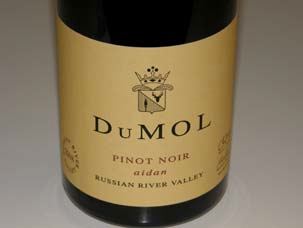 2008 DuMOL aiden Russian River Valley Pinot Noir 14.1% alc., 377 cases, scheduled release in the fall 2010. 100% Wildrose Vineyard, Dijon clones 115 and 777. Yields of 2 tons per acre. Aged 14 months in 50% new French oak barrels, bottled unfined and unfiltered. Strong argument for “Pinot of the Vintage” says Andy Smith. The 9-year-old vines are entering early maturity and their growth pattern requires little intervention. · Moderately dark reddish purple color in the glass. A Lolita that is offering plenty of youthful charm. Toasty oak envelopes the cherry and red currant aromas and flavors. The prominent tannins are ripe and a healthy grip of acidity is offered on the refreshing finish. Beautifully crafted to offer a spectacular drinking experience a few years down the road.
I must interject a very funny story about this last wine. When I left DuMOL winery, Andy offered me any of the wines to take with me and I chose this wine because it was a favorite. That evening I did not get a chance to drink it and left the next day for my home in Southern California. Once home, I put the opened and re-corked bottle in my kitchen Vinoteque at 60º. I left again for a trip and forgot about it. Almost 2 weeks later, I saw the bottle in my wine cabinet and opened it. The wine was fresh, gorgeously perfumed and flavored, as if it had been just opened. My wife and I happily finished it off that day. So, here was a wine that had been opened and re-corked, traveled 500 miles in my car, rested in my wine cabinet for 2 weeks and still tasted remarkably good. To me, this is a sign of superb winemaking and a wine that is in balance and has the longevity to go the distance. That said, don’t try this at home with just any wine! You will have to spend a little time studying the names of DuMOL wines to understand the vineyard sources. In 2008, the Pinot Noirs included a Russian River Valley appellation and Estate Vineyard bottling, and the named wines: ‘aiden’ (Russian River Valley Wildrose Vineyard), ‘ryan’ (Russian River Valley Dutton-Widdoes and Abbott vineyards), ‘finn’ (Russian River Valley Occidental, Widdoes Upper and DuMOL Estate vineyards), and ‘eoin’ (Carneros Sonoma Stage Vineyard). There are also 1 Russian River Valley appellation and 3 named Chardonnays, 1 Russian River Valley appellation and 2 named Syrahs, and a single named Viognier. The appellation wines are released in the spring and the designates in the fall. The winery sells most of their production through a Pre-Release Member list which has a wait list. If an allocation does become available, new members are offered a six bottle pack of two bottles each of the Russian River Valley Chardonnay, Pinot Noir and Syrah. The Pinot Noir designates except ‘ryan’ (production is larger and there is some market distribution), are sold only to Pre-Release Members. Sign up for the Pre- Release list at www.dumol.com. There is some restaurant distribution and very limited retail sale of DuMOL wines. DuMOL wines have been served at the White House and at the American Embassy in Paris, France. The winery is not open to the public. Contact Kerry Murphy at 707-925-254-8922 for information.
The woman will say, “I found this $100 wine on sale for $50 and then I had a coupon for 50% off and when I got to the register, there was a manager's special for an added 60% off, but come to find out it was a discontinued item with a manufacturer's rebate, so the sales girl gave it to me for $5.” Men say, “See this bottle of wine? Winery's suggested retail price, $100. I got it for $250. Beat that.
Pfendler Vineyards: Savor the GapPfendler Vineyards represents the legacy of Peter Pfendler, who first planted vineyards on Sonoma Mountain in 1992. He was a graduate of the United States Air Force Academy and served as a distinguished fighter pilot in Vietnam. He later founded Polaris Aircraft Leasing Corporation which became the world’s largest commercial aircraft leasing company. In 1989, Pfendler sold Polaris to General Electric and bought a 1000- acre ranch on Sonoma Mountain east of the town of Petaluma in Sonoma County, pursuing his life long dream of cattle ranching, wildlife and land conservation and winegrowing. Pfendler was fond of Cheval Blanc and other Bordeaux wines and planted Bordeaux varieties including Cabernet Franc, later discovering that these struggled to ripen in the cool climate. He also planted Pinot Noir and Chardonnay in Petaluma’s Gap’s Crown region, a very cool and windy area now highly regarded for its cool climate varieties. Before his untimely passing in 2007, veteran winemaker Don Baumhefner worked with Pfendler and bottled wines from Pfendler’s vineyards under the Copeland Creek label. Peter’s widow, Kimberly, who left a career in Creative Management in Hollywood in 2004 to marry Pfendler, chose to launch a luxury wine brand in his memory and christened the project Pfendler Vineyards, releasing the first Pinot Noir and Chardonnay with the 2007 vintage. All the previously existing Bordeaux plantings have been grafted over to Pinot Noir and Chardonnay, the two varietals Pfendler Vineyards now specializes in. Two wines are planned initially: an Estate Pinot Noir and an Estate Chardonnay. Noted winemaker and viticulturist, Greg Bjornstad, was hired to direct the winegrowing and winemaking. He has overseen the grafting of the Pfendler vineyards and updated the farming protocols including converting the trellising to a double Guyot configuration. Greg has worked as the viticulturist at Joseph Phelps Vineyards and Newton Vineyards. In 1996, he joined Flowers Vineyard & Winery as assistant winemaker and vineyard manager and during his tenure there, Flowers was awarded the title, “Artisan Winery of the Year,” twice, by Wine & Spirits magazine. In 1999, Bjornstad launched an international vineyard consulting business which included well-known North American clients such as DuMOL, Hirsch, Kistler, Kosta Browne, Paul Hobbs, Pisoni and Scott Paul. He founded his own label, Bjornstad Cellars, in 2005, specializing in vineyard-designated Pinot Noir and Chardonnay from Sonoma County appellations. Currently Pfendler Vineyards consists of 19 acres of Pinot Noir and Chardonnay distributed among four estate vineyards situation at varying altitudes on Sonoma Mountain in the Sonoma Coast appellation. The Penngrove Vineyard is a 6-acre parcel adjacent Gap’s Crown Vineyard and is planted to the Wente clone of Chardonnay and Dijon clones 114, 115, 777 and 828 and Swan selection of Pinot Noir. The Pullis Vineyard (Pullis is Kimberly’s maiden name) is the coolest and foggiest vineyard of the four, situated at about 1,000 feet on Sonoma Mountain. It was planted to Pinot Noir clone 828 in 2005. Pfendler Vineyard is part way up Sonoma Mountain at 1,200 feet in the middle of the fog line and sheltered from the wind. It was budded over from Cabernet Franc (planted in 1992) to the Hyde selection of Chardonnay (1 acre) and the Pommard 4 clone of Pinot Noir (3 acres) in 2008. The Helgren Vineyard sits at 2,000 to 2,200 feet near the mountain top and was budded over to Calera and Swan selections of Pinot Noir in 2008. The diversity in vineyard sites with their different soils, exposure, aspect, and altitude will give Bjornstad plenty of variety to work with to assemble the estate Pinot Noir, and the wines should pick up interest with each vintage as the newer plantings and grafted vines come into full production and he familiarizes himself with the different sites. Bjornstad’s Pinot Noir winemaking starts with vigorous sorting, 100% de-stemming, followed by native yeast fermentations. The cooperage program is evolving as Bjornstad seeks to match barrels to the multiple blocks of vines scattered throughout the four estate vineyards. Aging currently is in 50% new French oak barrels. Both Pinot Noir and Chardonnay receive 8 months of sur lies aging and are racked twice before being bottled unfined and unfiltered. Bjornstad’s trademark is pleasing textures and the Pfendler wines exhibit this beautifully. The wines are crafted at Vinify Wine Services in Santa Rosa. I recently visited Pfendler Vineyards and toured the four vineyards with Greg and Kimberly. It was a magnificent day and from the Pfendler home site, the Petaluma Gap could be clearly seen all the way to the Pacific Ocean. The first photo below shows the Petaluma Valley in the foreground and the Gap in the distance. The second photo is taken from the Halgren Vineyard, again showing the Gap in the far distance.


The Petaluma Gap is a term coined as recently as thirteen years ago and refers to a narrow coastal mountain opening in the southern Sonoma County countryside connecting the Pacific Ocean near Bodega Bay and Tomales to the San Francisco Bay. The Gap is roughly 22 to 31 miles in width with walls rising 2,000 to 3,000 feet above sea level. The western edge runs approximately from Tomales to Bodega. The southern border is the hamlet of Nicasio and the northern and eastern borders start around Penngrove and Cotati and run southeast along the Carneros Ridge, ending in San Pablo Bay. In the simplest of terms, the Petaluma Gap can be thought of as the area south of the Russian River Valley to Mt. Tamalpais in Marin County. On the map below I have roughly outlined the Petaluma Gap. Bodega is a few miles inland from Bodega Bay and Tomales is just east and south of Dillon Beach. The tiny town of Nicasio is a few miles east of where the Highway 1 marker is on the map. San Pablo Bay is the body of water bordered on the North by Highway 37.
 The Petaluma Gap region is not a separate appellation, but lies within the very large Sonoma Coast appellation. Wines from this region are currently labeled as Sonoma Coast appellation but the Petaluma Gap designation may be added in the future as the area becomes more well-known. The region could also eventually become its own appellation. The Petaluma Gap creates a very unique microclimate. Early morning ocean fog enters the Petaluma Valley, advances north through Cotati into the Russian River Valley and south to San Pablo Bay. Intense midday heat is moderated in the early afternoon by cooling Pacific Ocean breezes (thus the often-used term, “Petaluma Wind Gap,”) and chilly evening temperatures helps the ripening grapes maintain crisp, refreshing levels of acidity. The area has been compared to Carneros which is under similar climatic influences, but the fog and wind arrive earlier in the day than in Carneros and stay longer the next morning. Some areas of the Petaluma Gap are as cold, or even colder than Green Valley, Freestone, Santa Maria and Sta. Rita Hills. Rainfall is moderate (20 to 24 inches) so that irrigation is necessary for at least part of the growing season. In 2006, the Petaluma Gap Grape and Wine Alliance was formed to promote the region's identity (visit the website at www.petalumagap.com). The Petaluma Gap has a 150 year tradition of grape growing and currently there are over 3,000 acres of vineyards and four wine tasting facilities in the Petaluma Gap (Adobe Road, Corda, Kastania, and Keller Estate). An accurate map of the Petaluma Gap is available for viewing and purchase at www.themapstore.com.
2008 Pfendler Vineyards Estate Grown Sonoma Coast Chardonnay 14.5% alc., 200 cases, $38. Wente (4) clone. · Pale straw color in the glass. Shy upon opening revealing subtle aromas of fresh brioche, butter creme, poached pear and crushed rock with smoky oak showing up over time in the glass. Understated and seductive in style with appealing flavors of vanilla creme and lemon zest and the faintest cinnamon spice and minerality. Bright acidity lifts the pleasing finish. Still young and I am sure will match the 2007 version tit for tat with another year in the cellar. Very good.
 2008 Pfendler Vineyards Estate Grown Sonoma Coast Pinot Noir 14.5% alc., 400 cases, $45. · Swan selection and Dijon 114, 115, 777 and 828 clones. Very lovely, even captivating, perfume of ripe strawberries, raspberries, herbs, red licorice and graham. Tasty black raspberry and strawberry attack with a touch of earthiness. Beautifully composed with striking mid-palate intensity and a velvety mouth feel. Even at this young age, this is a charming wine that is drinking nicely and well worth your interest. Very good (+).
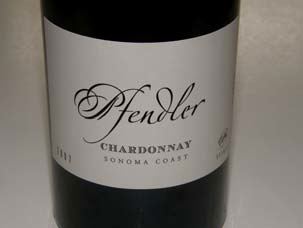 2007 Pfendler Vineyards Estate Grown Sonoma Coast Chardonnay 14.2% alc., $38. · A marvelous wine styled perfectly to my preferences. Complex nose of buttered popcorn, honey, lemon zest, honeydew and spiced apple. Delicious flavors of pear tart and baking spices. A demure wine that is beautifully proportioned with a lasting and aromatic finish.
2007 Pfendler Vineyards Estate Grown Sonoma Coast Pinot Noir 14.5% alc., 350 cases, $45. · Delicate aromas of well-oaked cherries and berries. Medium-weighted core of dark red stone fruits and blueberries with underlying oak toast. A gentle wine with admirable finesse, soft tannins and a silky mouthfeel, but with more intrusion of oak than I prefer. Decent.
Pfendler Vineyards is poised for success. The mature Chardonnay plantings are already showing their pedigree and Bjornstad will find his sure footing with the Pinot Noir with each passing vintage. Both Kimberly and Greg (pictured below) are cut out of the same mold, that is, soft spoken and disarmingly charming, creating a good match up for this new winery.

Bjørnstad Cellars: It’s About the VineyardGreg Bjornstad was raised on a farm in Colorado, earned a degree in viticulture from University of California at Davis, and held vineyard manager posts at Joseph Phelps Vineyards and Newton Vineyards. It was his stint at Flowers Vineyards & Winery on the Sonoma Coast that provided him valuable experience in cool climate viticulture and Pinot Noir and Chardonnay winemaking. As noted on a previous page, Flowers won the prestigious “Artisan Winery of the Year” Wine & Spirits magazine award two years in a row while Bjornstad worked there. In 1999, Bjornstad launched a successful international vineyard management and development consulting business and has assisted winegrowers in Russia, South Africa and Australia as well as several well-known winery clients in the United States. Partnering with Greg La Follette in Tandem Winery for several years, Bjornstad produced noteworthy Pinot Noir and Chardonnay from multiple Sonoma County vineyards. His own label, Bjørnstad Cellars, was started in 2005, specializing in vineyard-designated Pinot Noir and Chardonnay from prestigious vineyards in the Sonoma Coast, Russian River Valley, Sonoma Mountain and Bennet Valley regions. Bjornstad is pronounced “Byurn-sted,” Norwegian for “bear place,” accounting for the unique bear paw logo for the winery.
 Bjornstad has one up on many winemakers in that his training and experience has centered on viticulture. He has worked with the same growers for over 12 years and says, “I believe that human relationships also find their expression through grapes and wines. I believe that each vineyard’s terroir, or sense of place, is defined by the soil and climate but shaped by the steward.” His lineup of vineyard sources reads like a list of California grand cru sites and includes Ritchie Vineyard and Porter-Bass Vineyard for Chardonnay and Hellenthal Vineyard and van der Kamp Vineyard for Pinot Noir. Winemaking for Pinot Noir begins with careful sorting, then de-stemming of the grapes, followed by a cold soak for up to 10 days. The wines are raised on the lees (sur lies) for at least 8 months in about 50% new French oak. Native yeast fermentations are the goal in most wines. The Chardonnay pressing regime is dictated by the vintage and condition of the fruit as to choice of whole cluster or de-stemming. Native yeast fermentation is employed except with the Musque clone portions of the Porter-Bass and Ritchie Vineyard Chardonnays. Aging is carried out sur lies in barrel with about 50% new French oak. This is non-interventional winemaking practiced in its highest form, with Bjornstad looking in on the wines just to insure that there are no surprises and the barrels remain full during aging. Two rackings are employed from barrel and back before bottling to preserve the freshness and character of the wines. As I tasted through Bjornstad’s current releases of Chardonnay and Pinot Noir, I was struck by the silky texture of the wines, particularly in the Pinot Noirs. For Pinot Noir fanciers, one of the wine’s greatest attribute is it’s sensual texture and if you Google “silky texture of Pinot Noir,” you will find about 105,000 results. That is not to say that every Pinot Noir has the mouth feel of silk sheets, but it is a goal that many winemakers strive for. Research has found that a group of naturally occurring substances in grapes called pectins, which are members of the polysaccharide family, are important in producing soft texture in wine. Other polysaccharides are derived from yeasts that are released when the cell walls break down after the yeasts complete fermentation and die. The ways in which polysaccharides influence the textural quality of wine, as well as the contribution of tannins is not well defined. Suffice it to say, Bjornstad has it dialed in. All the Bjørnstad Cellars wines are stellar and reviewing them is an easy task. Picking which one is better or worse is like splitting hairs.
2007 Bjørnstad Sonoma County Chardonnay 14.2% alc., 221 cases, $25, released May 15, 2010. · Appealing aromas of cooked pear, brown butter, caramel and oak fading some in the glass replaced by green apple notes. Tasty citrus and pear flavors with a hint of honey. Not as rich or striking as the vineyard-designated Chardonnays, but a solid wine with a slightly creamy mouth feel and a bright, clingy finish. A go-to wine for everyday enjoyment. Good.
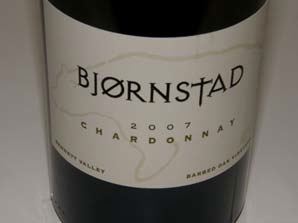 2007 Bjørnstad Barbed Oak Vineyard Bennett Valley Chardonnay 14.2% alc., 116 cases, $30, released January 15, 2010. This vineyard was planted to Chardonnay and Pinot Noir in 2005 on well-drained Spreckles Series soils. The Bennett Valley AVA is a very cool region due to the onshore winds of the Pacific Ocean which enter through the Petaluma Gap. · This is a very charming wine with an alluring perfume of nectarine, banana and butter evolving in the glass to aromas of lemon and brown spice. Delicious on the palate with discreetly rich flavors of buttered toast, malted milk, roasted nuts, lemon, and poached white peaches that persist on the endless lemony finish. Harmonious in every way with the signature Bjornstad creaminess on display. Very good.
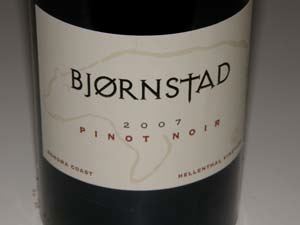 2007 Bjønstad Hellenthal Vineyard Sonoma Coast Pinot Noir 14.4% alc., 152 cases, $40, released March 1, 2010. Gard and Lori Hellenthal first planted this vineyard in the true Sonoma Coast in 1980. Bjornstad directed the planting and farming of a newer block developed beginning in 2000 from which Bjornstad is the sole recipient. · A savory aroma profile showing intense plum fruit, forest floor, and a hint of oak. Wellendowed with a hearty core of dark red and black fruits, game and earth. You can almost taste the soil in this wine. Healthy, but ripe tannins, a satiny mouth feel, and impressive persistence on the feral finish. Hellenthal Pinot Noirs can be monolithic and tannic, but this wine shows none of these traits. The best Pinot Noir I have ever had from this vineyard. Still singing the next day from an opened and recorked bottle indicating balance and age ability. A California classic.
2007 Bjønstad Porter-Bass Vineyard Sonoma Coast Chardonnay 14.1% alc., 64 cases, $40, released October 1, 2009. This vineyard dates to 1980 and is farmed organically and biodynamically. Clones are Rued (a Musque selection) and Wente. Soils are gravelly clay loam, a fractured shale that commonly underlies the Goldridge Series. Bjornstad has worked with this vineyard since 1997. · Nuanced aromatic profile of lemon meringue, rock quarry, chalk dust, grass and a hint of oak. Very smooth and creamy in the mouth with flavors of green apple, pastry cream, citrus and a striking minerality. Discreet richness, facile tannins and a tangy finish. The most Chablis-like Chardonnay in the lineup. Very good.
2007 Bjørnstad Ritchie Vineyard Russian River Valley Chardonnay 14.7% alc., 200 cases, $40, released May 1, 2010. This revered vineyard has been farmed by Kent Ritchie since 1972. The soils are in the Goldridge Series and are well drained, sandy loams. The Bjornstad block is planted to an Old Wente field selection that includes a very floral clone known as Musque. Bjornstad has worked with Kent and his fruit since 1997. · Slight haze in the glass (unfiltered). Shy but pleasing aromas of lemon zest, toffee, vanilla and crushed rock, with a whiff of alcohol peaking out. Rich and full-bodied flavors of golden apple and pears with a bright accent of minerality. There is deft use of oak and a striking creaminess to the texture. The biggest Chardonnay in the lineup and the most Caliesque. This wine will find many hedonistic-seeking fans. Very good.
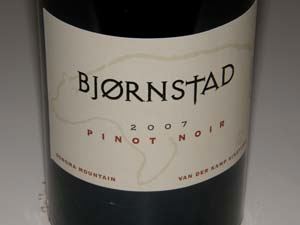 2007 Bjørnstad van der Kamp Vineyard Sonoma Mountain Pinot Noir 14.5%, 128 cases, $40, released October 1, 2009. This cherished vineyard, farmed by the van der Kamp family, has some of the oldest Pinot Noir vines in Sonoma County. · Pinot Noir from this mature vineyard always possesses distinctive and interesting nuances. The aromas are more savory than fruity and feature wild berries, smoky oak and a hint of barnyard. On the palate, darker fruits are underlain with an appealing earthiness and meatiness. The tannins are reigned in and there is a good nip of acidity on the bright finish. My notes say, “Love the texture!” The wine picks up interest and intensity as it opens in the glass over time. Still drank beautifully the next day from an opened and re-corked bottle. You need some of this.
Bjønstad Cellars wines are sold primarily through a mailing list and through the online store at www.bjornstadcellars.com. The wines are extremely well priced considering the quality. The website is very informative and easy to navigate. Follow the winery on Facebook (www.facebook.com/bjornstadcellars) and Twitter (www.twitter.com/bjornstadwines).
Chardonnay: What Gives In PinotFile?Ok, I have come out of the closet. I have another paramour: Chardonnay. You will notice the first appearance of the “Golden Geek” and “Golden Value” icons in this issue, and like their Pinot Noir counterparts, represent the best in Chardonnay (Golden Geek) and the best values in Chardonnay (Golden Value).
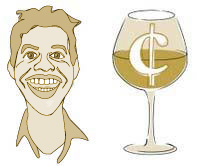 As of late, many Pinot Noir producers have also been sending me their Chardonnays to review, especially after they find out that I enjoy and drink Chardonnay regularly as my white wine of choice. That is not to say that the PinotFile will taken on a “bi” proclivity. The overwhelming emphasis will forever remain on Pinot Noir. Chardonnay is not a true part of the Pinot family of Pinot Noir, Pinot Gris and Pinot Blanc, but as shown by researchers at University of California at Davis in 1999, is most likely derived from a fling in the distant past between Gouvais Blanc and Pinot Noir. The early plantings of Chardonnay in California in the 1970s were primarily Wente clone. In 1912, a member of the Wente family took cuttings from the University of Montpellier viticultural nursery in France and planted them in the Livermore Valley of California. Cuttings from the Wente vineyard then spread to many wineries and eventually the Wente clone was certified by the Foundation Plants Material Service at University of California at Davis. The clones from certified vines are called “Wente clone” or UCD 4. The clones taken before certification are called “Old Wente” and designated 2A. Thus, not all Wente clones are the same, and older vineyards in California planted to Old Wente are highly prized. The Wente clone is moderate yielding and shy-bearing, producing a rich mouthfeel, and aromas and flavor tones of tropical, floral and Muscat notes with nutmeg and clove spice. The Dijon clones of Chardonnay were brought to North America by the Oregonians, who found that the Wente and Draper clones from California performed poorly in Oregon, failing to ripen and producing wines that were thin, acidic and lacking in character. As a result of the efforts of vintner David Adelsheim and others beginning in 1974, Dijon clones were eventually widely introduced in Oregon and produced Chardonnays with excellent structure and balanced acidity. The Dijon clones matured before the bad weather set in at the end of Oregon’s harvest, proving to be a better match to Oregon’s climate. The early Dijon Chardonnay clones were certified in 1997 (75, 76, 96 and 98) and 1988 (77, 95, 277). As of 2006, 34 clonal varieties of Chardonnay were planted in vineyards throughout France, most of which were Dijon clones developed at the University of Burgundy. Dijon 76, 95 and 96 are said to produce more flavor-concentrated clusters, Dijon 77 and 809 more aromatic wines with a “grapey” perfume, and Dijon 75, 78, 121, 124, 125 and 277 are more vigorous and higher yielding. These clones provide Chardonnays with citrus, stone, melon and tropical aromas and flavors. There are a number of other clones and/or selections that have appeared through the years in California. The Hanzell clone came from Wente clone cuttings at Stony Hill in Napa Valley. This clone is shy-bearing and known for millerendage or “hens and chicks,” clusters of grapes with some normal-size berries, but many small and seedless berries. This phenomenon is more exaggerated in the Hanzell clone than in other Old Wente plantings in California and confers a distinction on Hanzell Chardonnay (see pages 1-10 in this issue). Still other Chardonnay varieties include the Robert Young selections, Draper (Ridge), Mt. Eden, Monticello, Sees (Miramar Torres), Hyde, Hudson, and Musqué, made famous at Matanzas Creek and representing several different mutations of the Chardonnay grape that produce Muscat-like or floral aromas. Some of California’s most prized Chardonnay vineyards include Hyde and Hudson in Carneros, Heintz in the Sonoma Coast (25 acres of clone 4 on AXR1 planted in 1982), Ritchie in the Russian River Valley (Musqué and Wente planted in 1972), Hirsch and Marcassin in the Sonoma Coast, Durell on Sonoma Mountain (some Old Wente clone planted in 1979) and Kistler (Old Wente and Mt. Eden clones. Kistler also has some Old Wente planted at Vine Hill Vineyard, McCrea Vineyard and other newer vineyards). The most promising appellations for Chardonnay in California? Santa Rita Hills has to be at or near the top of the list, yet most producers here prefer to concentrate on Pinot Noir. I would love to taste some Chardonnay from the Sta. Rita Hills AVA crafted by Ted Lemon, Steve Kistler or Helen Turley. Other appellations that have shown exceptional metal include the Santa Cruz Mountains, Carneros, Sonoma Coast, and Mendocino Ridge. The aromas and flavors of barrel-fermented Chardonnay derive not only from the fruit itself, but from malolactic fermentation, oak barrel aging and the terroir of the vineyard source. Malolactic fermentation produces tones of butter, creme and hazelnut, light oak leads to tones of vanilla, coconut, and sweet wood, heavy oak imparts tones of oak, smoke and toast, and terroir is reflected in tones of flint, minerals, and mint. Stainless-steel fermented Chardonnay has fans as well, with its proponents touting the pure expression of the fruit and terroir. Matching food with California Chardonnay? It will, of course, depend on the style of Chardonnay, but I often turn to fritto miso, pommes frites, caesar salad, potato chips, buttered and salted popcorn, and of course, lobster with drawn butter. Try grilled butterflied leg of lamb as well and you will be surprised. I reviewed the following Chardonnays in the past couple of months. California Chardonnay, unlike Pinot Noir, is more dependable with better examples at lower price points. High-end producers like Marcassin, Peter Michael, Kistler, and Kongsgaard can demand close to $100 a bottle, but when you taste these wines, you can readily appreciate the quality difference compared to lesser-priced examples. Once you get hooked, the habit will be an inescapable draw on your pocketbook. It is one of the facts of life: great wine costs money. That said, there are many California Chardonnays in the value-priced range that can offer perfectly satisfying drinking on a daily basis without impugning your credit score. The current pantheon of Chardonnay producers includes: Aubert, duMOL, Hanzell, Kistler, Kongsgaard, Littorai, Marcassin, Mount Eden, Pahlmeyer, Paul Hobbs, Peter Michael, Ramey and Stony Hill. There are many other wineries nipping at their heels, as shown by the reviews below of Chardonnays tasted in the past few months.
2007 Pahlmeyer Napa Valley Chardonnay 14.9% alc., $40. Pahlmeyer has run into a bit of a financial pinch of late and you can find their wines heavily discounted. · Golden yellow color in the glass. Appealing aromas of lemon curd, light caramel, butter and toast. Soft and strikingly creamy on the palate with flavors of white grapes, white peaches, brioche and toasty oak. Plenty of tannin and acidity to balance the prodigious fruit. A consistent favorite among fans of California full-on Chardonnay. Very good (+).
2007 J Vineyards Russian River Valley Chardonnay 14.3% alc., $28. · Light straw colored in the glass. Toasty oak and sawdust dominate the green apple aromas. Very tasty glazed apple and pear flavors with underlying notes of light caramel, brioche and oak. California-styled with plenty of oakderived aromas and flavors that will find favor with many Chardonnay lovers. Good.
2007 Robert Stemmler Estate Grown Carneros Chardonnay 14.1% alc., $25. Clones are Old Wente, Weimer and Dijon. Whole cluster pressed, cold fermented, aged in 40% new French oak, stirred on its lees, partial MLF. · Light yellow in color in the glass. Has the aromas and flavors of an older wine and this bottle may be slightly oxidized. On the nose, poached pear and shoe box are noted and the flavors veer toward roasted peach, kumquat and grilled apricot with accents of caramel, brown sugar and stewed apple. Moderately rich, very smoothly textured and easy to drink. Decent.
2004 Littorai Charles Heintz Vineyard Sonoma Coast Pinot Noir 14.2% alc.. · Moderate straw color in the glass. Shy perfume of lemon tart, espresso and oak toast with a hint of funk that dissipates with time in the glass. Tasty flavors of lemons, Asian pear and coffee with a subtle note of oak-derived burned marshmallow in the background. Plenty of finesse and well proportioned acidity. Like most of Ted Lemon’s wines, they don’t come to you, you have to seek out the nuances. Very good (-).
2007 Peirson Meyer Charles Heintz Vineyard Sonoma Coast Chardonnay 14.4% alc., 450 cases, $55. The companion label of l’Angevin named after the two proprietor families, Robbie (winemaker with stints at Lewis Cellars and Peter Michael) and Shannon Meyer, and Alan and Lesley Warner Peirson. Barrel fermented, wild yeast fermentation, 100% MLF, aged 15 months in 50% new French oak, unfined and unfiltered. · Moderate straw color in the glass. The aromas really come at you over time in the glass showing lemon curd, creme brulee, vanilla wafer and wet stones. Flat-out delicious flavors of golden apple, pear, melon and freshly buttered brioche that are palate staining and hang around on the finish for what seems like a minute. Very smoothly textured with perfect integration of oak. This wine would make any Frenchman green with envy. My favorite Chardonnay from California and one I buy by the case and in magnums when my wife isn’t looking over my shoulder. Wowza! (Also drank a bottle in 2012 and was equally wowed).
2007 Freestone Vineyards Ovation Sonoma Coast Chardonnay 14.0% alc., $45. 61% estate grapes, 21% Dutton Ranch, 18% Bacigalupi Vineyard. Aged 15 months in 60% new and 40% two to three-year-old French oak barrels. Weekly stirring of the lees before MLF. Freestone’s node to California-styled Chardonnay. · Light golden yellow color in the glass. Demure aromas of lemon curd, pear, white peach and a steely minerality that carries over on the palate. Delicious core of citrus and pear flavors with complimentary notes of caramel, baking spices and a citrus tang that persists on the refreshingly dry finish. Very good.
2007 Three Saints Santa Maria Valley Chardonnay 14.1% alc., pH 3.09, 3,000 cases, $20. Whole cluster pressed, native and inoculated fermentations. Initial fermentation is finished in barrel and partial MLF occurs in barrel. Twice weekly lees stirring. Lightly fined and unfiltered. · Crisp, juicy and refreshing with aromas and flavors of lemons, white peaches, pears and oak. A little sweetness on the finish is not my cup of tea, but this style will have many fans. A solid choice for short-term daily drinking. Decent.
2007 Bonterra Vineyards Mendocino County Chardonnay 13.0% alc., pH 3.27, $12, screw cap. 96% Chardonnay, 3% Muscat, 0.5% Rousanne, 0.5% Viognier. Made from organic grapes and aged in primarily neutral French and American oak. The winemaker is Robert Blue. · Very pale yellow-green in the glass. Appealing aromas of lemon curd, banana, vanilla and oak toast. Discreetly rich and soft in the mouth with flavors of citrus fruits, creme brulee and vanilla wafers. A bit hollow in the mid-palate and becomes less interesting in the glass over time, but a value-priced play that will work well when mildly chilled at the dinner table. Good.
2007 LIOCO Sonoma County Chardonnay 14.5% alc,, $20, screw cap. Fermented in stainless steel using wild yeast. Aged in tank 5 months on lees. Bottled unfined and unfiltered. · Pale yellow color with slight haze in the glass. Aromas of lemons, honey, yeast and popcorn. Luscious and full-flavored with bright crunchy fruit that jumps out of the glass. Accents of roasted nuts, pears, honey and nutmeg add interest. Smoothly textured with bright acidity. The essence of Chardonnay. Good (+).
2007 Lucas & Lewellen Santa Barbara County Chardonnay 13.7% alc., $18. Stainless steel fermented grapes from younger vines at Los Alamos and Goodchild vineyards in northern Santa Barbara County. · Clear pale yellow color in the glass. A nice little Chardonnay with typical varietal aromas of pears, white peach, melon, lemon and cut flowers. The flavors echo the aromas with a slight grassy, herbal and resin flavor. Soft and crisp in the mouth. Good.
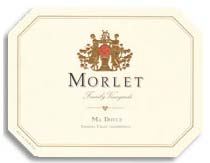 2007 Morlet Family Vineyards ‘Ma Douce’ Sonoma Coast Chardonnay 360 cases, $70. From a vineyard on the second ridge from the Pacific Ocean. Dedicated to Luc Morlet’s spouse, Jodie, and named ‘My Sweet’ or ‘Ma Douce.’ Native yeast, 100% MLF, weekly batonnage. Unfiltered. · Moderately deep straw yellow color in the glass. Piercing aromas of lemon curd, yeast, roasted nuts and smoky oak. Plush and luxurious on the palate, yet vibrant with acidity and minerality. Enticing flavors of white peach and buttered brioche linger on the refreshing finish. A very impressive wine that was still pumping out bright flavor three days later from an opened, re-corked and non-refrigerated bottle. Decant this wine if you pop the cork now. One of the greatest California Chardonnays to cross my lips. Sold out at the winery and understandably so. Still available through retail channels on the internet.
This newer winery has been widely acclaimed by Robert Parker, Jr., and Steven Tanzer and rapidly took on a cult image shortly after its founding in 2006. Morlet Family Vineyards is the project of Luc and Jodie Morlet who handcraft vineyard designated wines and unique cuvées from vineyards in Napa Valley and Sonoma County, several of which they have long-term contracts with and direct the farming. Luc Morlet is a fourth generation, France-born wine maker who grew up on his family's domaine in Champagne. He worked in vineyards and wineries in Burgundy and Bordeaux before venturing to California. There he became winemaker for Newton, Staglin and Peter Michael Winery, where he still consults to his brother, Nicolas, who succeeded him as full-time winemaker. Besides the 'Ma Douce,' there is a 'Ma Princesse' Russian River Valley Chardonnay and the 'Coup de Coeur' Sonoma County Chardonnay which represents the best barrels of the vintage and consists of only 75 cases. The Chardonnays are based on Old Wente clones and are styled similar to the Chardonnays from Peter Michael. In addition, there are three Sonoma Coast Pinot Noirs, each of which is produced in 100 case lots, a Sauvignon Blanc, Muscadelle and Semillon blend named 'La Proportion Doree,' a Bennett Valley Syrah, three Cabernet Sauvignons from Napa Valley, and a Late Harvest Semillon from Alexander Valley. I met Luc Morlet at a special wine dinner at Charlie Palmer at Bloomingdale's in Costa Mesa's South Coast Plaza on April 14, 2010. Both Peter Michael and Morlet Family Vineyards wines were featured along with the cuisine of Amar Santana. My favorite course was Sonoma quail stuffed with sweet Italian sausage, sweet pea puree and braised morel jus paired with the 2008 Morlet 'Côteaux Nobles' Sonoma Coast Pinot Noir. I will review all the Morlet Pinot Noirs in an upcoming issue.
 Morlet Family Vineyards wines are sold primarily through a mailing list at www.morletwines.com with some fine restaurant distribution and very limited retail sales. For those of you shut out of the Peter Michael mailing list, this is a perfect opportunity to hop on board the Morlet mailing list.
Pinot BriefsEuropean Grape Moth Quarantine The grapevine moths are native to Mediterranean Europe and presumably showed up in Napa Valley last year by way of smuggled suitcase vine cuttings. One Oakville vineyard was devastated and others were damaged. The moth larvae invade the grapes and infect them with botrytis or bunch rot. Quarantine areas are either being proposed or already instituted in Sonoma, Mendocino, Solano, Merced and Fresno counties. Aggressive action now can lead to eradication of the pest in California. Surprise At Consumer Wine Awards A wine competition was held in Lodi, California in which more than 90 consumers used a new tasting methodology devised by industry experts to judge 550 wine entries from around the world. The consumer panels awarded more than 200 medals (www.consumerwineawards.com) to a spectrum of varietals from sweet to dry with the top three wines technically sweet and two having more than 3% residual sugar. The results confirmed that consumer preferences are quite different from professional tasters. There is still plenty of data to review, but a survey conducted in conjunction with the Consumer Wine Awards at Lodi showed consistent preferences for salt and sweetness that correlate to general wine flavor preferences. A separate study in the Consumer Wine Awards showed that expert judges are more consistent with their scores than the consumer wine evaluators. The event was created by Tim Hanni MW, G.M. “Pooch” Pucilowski and Aaron Kidder. The Consumer’s Platinum Medal Winning Pinot Noir was the 2007 Nicholson Ranch Cactus Hill Reserve Estate Sonoma Valley Pinot Noir. Oregon Wine Industry Symposium Reports Big Harvest in 2009 Data from the Oregon Wine Board and Ciatti Co. indicate that the 2009 crop in Oregon was 23% more than 2008. Oregon’s Pinot Noir crush in 2009 was 28,000 tons compared to 17,500 tons in 2008. Oregon will definitely be facing a surplus of wine for the next several years, especially with lower sales in the current economic milieu. Oregon’s portion of United States wine production was 0.8% in 2009. Crushpad Winery Moves to Napa ValleyFounded in 2004, Crushpad was a popular urban San Francisco winery for several tiny producers of artisan Pinot Noir. Crushpad’s new location is at the Silverado Trail Wine Studios owned by Premier Pacific Vineyards which supplies much of the grapes for Crushpad’s customers. 1996 Krug Clos d’Ambonnay Released in April 2010 Clos d’Ambonnay is a tiny monopole of under 2 acres located in Montagne de Reims and planted solely to Pinot Noir. The 1996 vintage was legendary for Champagne and the Krug Clos d’Ambonnay reflects this, with a release price of $5,000 per bottle, available only on pre-release in six-bottle lots at $30,000! This is the last wine blended by three generations of the Krug family. Pinot Noir #5 in Market Share Nielsen reports that through December 12, 2009, the top five wine varieties by market share are Chardonnay, Cabernet Sauvignon, Merlot, Pinot Grigio/Gris and Pinot Noir with growth still evident for Pinot Noir, Sauvignon Blanc and Riesling. Virgin America and Qantas Take In Flight Wine to New Levels Virgin America is now offering a new wine selection designed by wine expert Gary Vaynerchuk and are rolling out an expanded onboard menu. Vaynerchuck’s Wine Library TV will be shown on the airline’s in-flight entertainment system and in-flight wine tasting with Vaynerchuk in First Class is planned. On another airline front, noted wine expert Dan Berger has judged Qantas to have the finest wine list of 33 airlines. Sonoma County Label Change Proposal Sonoma County’s wine and grape trade groups have recently thrown in their support for the proposed Sonoma County wine label law that requires wines made from Sonoma County grapes to carry Sonoma County on the label. Similar laws exist for Napa, Paso Robles and Lodi. Mobile Application for Inebriated Drivers A free mobile application called TaxiMagic has been introduced by California State officials. All registered users have to do is tap on button on their iPhone, BlackBerry, Android and Palm smart phones and the application determines where the caller is, contacts the cap company, and dispatches the cab to the caller’s location automatically. The user can automatically pay by credit card. Users can also book a cab with the mobile application, on the web, or with a text message. For more information visit www.taximagic.com.
Words of Wine Wisdom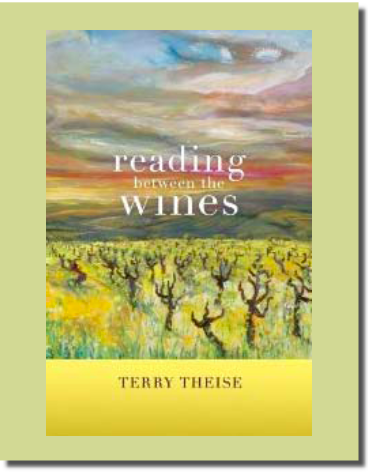 Terry Thiese is a distinguished American wine merchant who specializes in wines from Austria, Champagne and Germany, and has been included in The Wine Advocate’s “Most Important Wine Personalities of the last 25 years.” He was quoted in The World of Fine Wine (Issue 25, 2009) as saying his career “is a model of what successes are possible given a combination of utopianism, fanaticism, and poor business sense.” In an article in the same issue titled, “Values in Wine. An Attempt to Codify,” Thiese made a number of provoking statements about wine that were so timely and true that I had to repeat them here for you to chew on. This article will appear in an adapted form in the forthcoming book, Reading Between the Wines, to be published in September 2010 by the University of California Press. I can’t wait to get my hands on it.
“I’d rather drink something that tastes like something and not like everything. Anything can taste like everything - and too often it does, and it bores the crap out of me.” “Some wines deserve your entire field of attention, but these are almost never the ones that scream in order to get it. Modest wines are endangered in these times, when power is overvalued. Just because your text is written in bold, it doesn’t mean you have anything to say.” “When ripeness is sufficient, why do we assume over ripeness will be preferable?” “The argument that only ambient vineyard yeasts can convey terroir is otiose. Each choice a producer makes to start the fermentation has advantages and disadvantages - and with very few exceptions, none is ‘morally’ preferable to another.” |